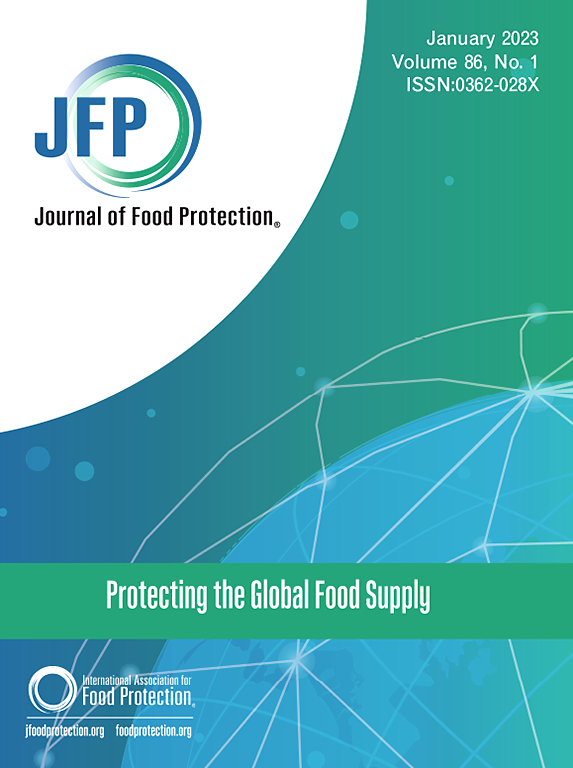Quantification of Salmonella in Raw Poultry Using Droplet Digital PCR With a Whole Cell, Enrichment-free Approach
IF 2.1
4区 农林科学
Q3 BIOTECHNOLOGY & APPLIED MICROBIOLOGY
引用次数: 0
Abstract
Salmonella contamination in poultry remains a persistent public health challenge, despite ongoing regulatory efforts to reduce its presence. Traditional culture-based enrichment methods commonly employed for detecting Salmonella have inherent limitations, such as biases in bacterial growth and inaccurate quantification of initial contamination levels. This study introduces an enrichment-free approach for quantifying Salmonella in raw poultry, utilizing the Pathotrak system for bacterial separation and concentration, followed by Droplet Digital PCR (ddPCR) for absolute quantification. Our findings highlight that whole-cell preparations within ddPCR droplets yield significantly higher detection efficiency compared to extracted DNA, likely due to the reduced loss of genetic material during processing. The method was validated by correlating theoretical inoculation levels with ddPCR measurements, resulting in a strong linear relationship (R2 = 0.903) and a slope of 0.99, indicating high accuracy. Residuals from the regression model were normally distributed, confirming its validity. This platform offers a robust, rapid, and precise tool for detecting low levels of Salmonella in poultry products without enrichment, making it a more accurate and efficient approach to bacterial quantification in complex food matrices.
用全细胞无富集法滴滴数字PCR定量生禽沙门氏菌
家禽中的沙门氏菌污染仍然是一个持续的公共卫生挑战,尽管监管机构正在努力减少其存在。通常用于检测沙门氏菌的传统的基于培养的富集方法具有固有的局限性,例如细菌生长的偏差和对初始污染水平的不准确量化。本研究介绍了一种无富集的方法来定量生禽沙门氏菌,利用Pathotrak系统进行细菌分离和浓缩,然后用液滴数字PCR (ddPCR)进行绝对定量。我们的研究结果强调,与提取DNA相比,ddPCR液滴内的全细胞制备产生了显着更高的检测效率,这可能是由于在处理过程中减少了遗传物质的损失。通过将理论接种量与ddPCR测量值进行关联,验证了该方法的有效性,结果表明该方法具有较强的线性关系(R2 = 0.903),斜率为0.99,表明该方法具有较高的准确性。回归模型残差符合正态分布,验证了回归模型的有效性。该平台提供了一种强大、快速和精确的工具,可在不富集的情况下检测家禽产品中的低水平沙门氏菌,使其成为复杂食品基质中细菌定量的更准确和有效的方法。
本文章由计算机程序翻译,如有差异,请以英文原文为准。
求助全文
约1分钟内获得全文
求助全文
来源期刊

Journal of food protection
工程技术-生物工程与应用微生物
CiteScore
4.20
自引率
5.00%
发文量
296
审稿时长
2.5 months
期刊介绍:
The Journal of Food Protection® (JFP) is an international, monthly scientific journal in the English language published by the International Association for Food Protection (IAFP). JFP publishes research and review articles on all aspects of food protection and safety. Major emphases of JFP are placed on studies dealing with:
Tracking, detecting (including traditional, molecular, and real-time), inactivating, and controlling food-related hazards, including microorganisms (including antibiotic resistance), microbial (mycotoxins, seafood toxins) and non-microbial toxins (heavy metals, pesticides, veterinary drug residues, migrants from food packaging, and processing contaminants), allergens and pests (insects, rodents) in human food, pet food and animal feed throughout the food chain;
Microbiological food quality and traditional/novel methods to assay microbiological food quality;
Prevention of food-related hazards and food spoilage through food preservatives and thermal/non-thermal processes, including process validation;
Food fermentations and food-related probiotics;
Safe food handling practices during pre-harvest, harvest, post-harvest, distribution and consumption, including food safety education for retailers, foodservice, and consumers;
Risk assessments for food-related hazards;
Economic impact of food-related hazards, foodborne illness, food loss, food spoilage, and adulterated foods;
Food fraud, food authentication, food defense, and foodborne disease outbreak investigations.
 求助内容:
求助内容: 应助结果提醒方式:
应助结果提醒方式:


